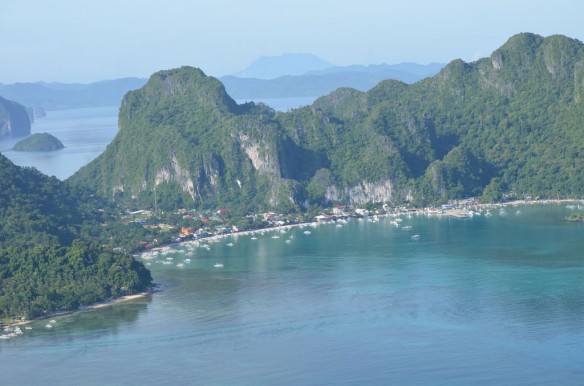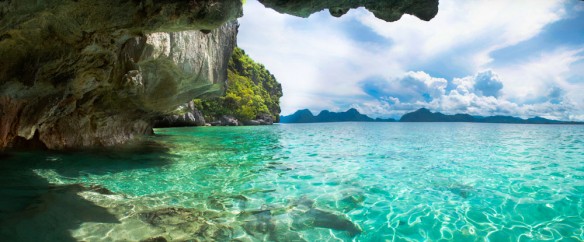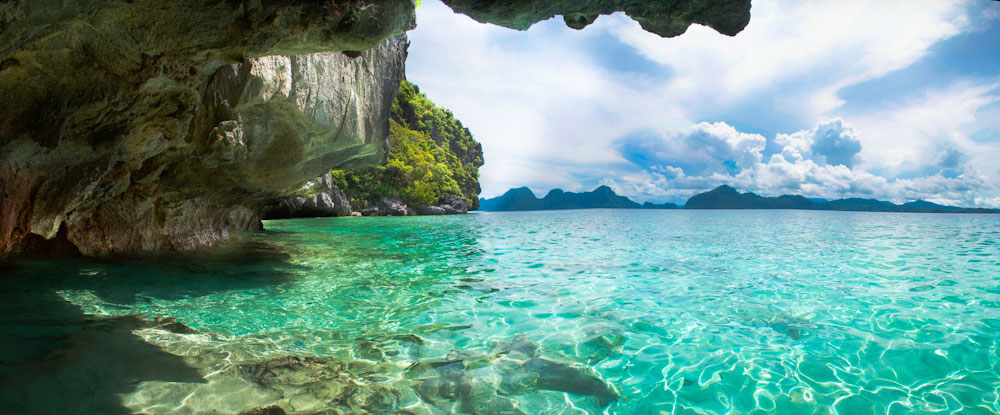
El Nido, Philippines. Photo source: ©© Philippe Fly Boy
By UNEP;
About 420 kilometers south-west of Manila, in Bacuit Bay, lies the largest marine sanctuary in the Philippines. El Nido is a protected area of 45 islands and islets covering a total of 903 square kilometers, and boasts one of the most diverse ecosystems in the region.
El Nido is protected for its breathtaking geological formations, and unique flora and fauna, which include over 447 reef-building coral species, and 44 unconfirmed species – making it a scuba diving and snorkeling paradise.
In the last 10 years the number of tourists flocking to El Nido has more than tripled. In 2013 the famed marine sanctuary welcomed over 60,000 tourists to its white sand beaches, lush mangrove and ever-green forests, and magnificently sculpted jade islands.
Across the Asia-Pacific region and the Indian Ocean, Green Fins provides the only internationally recognized set of environmental standards to provide guidance and support for business owners and national authorities to promote best practices in sustainable tourism – particularly scuba diving and snorkeling.
Coordinated internationally by The Reef-World Foundation and supported by the United Nations Environment Programme (UNEP) and other partners, Green Fins ensures that diving companies, and tour services, are regularly assessed against the Green Fins internationally recognized environmental Code of Conduct, and that business owners and staff are appropriately trained in environmental best practices.
While tourism is a mainstay of El Nido’s local economy, it is also an industry that is especially sensitive to reef conditions. Once coral reefs are damaged, their ability to support the many creatures that depend on them is greatly diminished. As a consequence, those reefs and local areas lose their attraction as tourist destinations.
“The coral cover of living hard corals is about 26 per cent, which is fair. Meanwhile, soft corals average 4 per cent, which is typically low,” said Irma Rose Marcelo, Executive Director of El Nido Foundation Inc. (ENFI).
“Tourism in El Nido remains both an opportunity and a threat. It is a threat because corals are exposed to anchor damage, snorkeler and diver damage, boat strike, and pollution.”
According to the Head of UNEP’s Coral Reef Unit, Jerker Tamelander, “intensive diving and snorkeling tourism can be a significant driver of reef degradation, and may leave reefs more vulnerable to other stress including climate change.”
It has been estimated by the Global Coral Reef Monitoring Network that the world has effectively lost 19 per cent of productive reef area, with another 15 per cent under immediate threat of loss. Approximately 500 million people depend on coral reefs for food, coastal protection, and income from tourism, including 30 million who are totally dependent on coral reefs for their livelihoods or for the land they live on.
As a result, when reefs are degraded, millions of people are deprived of the goods and services they provide, such as food from fish, mollusks and algae, tourism benefits and shoreline protection.
Ramil Panganiban, El Nido snorkeling and dive shop owner is adamant that snorkeling and diving should be a sustainable activity. “If we do not protect the environment, we will go out of business,” he said. Now it turns out that sustainability is paying dividends for Mr. Panganiban, who started his company with just a table and a bond of paper to let people know of his business in 2011, and now caters 10 to 20 tours a month, with three boats and a shop.
Sustainable tourism is an important means of safeguarding ecosystems while ensuring that local communities and businesses benefit from tourism. By introducing more sustainable consumption and production patterns into the tourism sector, resources can be better managed, costs lowered, and biodiversity protected.
Reef World Foundation project manager Samantha Craven described the Code of Conduct as a 15-point best practices guide that covers the operation both in and out of the water. “It is a combination of what to do and what not to do, to drive a sustainable industry, and as basis for Green Fins membership,” she said.
To ensure that best practices are followed, dive and snorkel shop operators and guides attend yearly Code of Conduct trainings and assessments.
The Code of Conduct best practices includes: Adhere to the Green Fins Friendly Diving and Snorkeling Guidelines and act as a responsible role model for guests; provide adequate garbage facilities on board facility’s vessel and deal with responsibly; and abide by all local, regional and international environmental laws, regulations, and customs.
“In the Philippines, around 130 dive centers are registered Green Fins members and globally over 260. It’s a number that keeps growing as we also introduce the program in Vietnam and the Maldives,” said Ms. Craven.
Since the introduction of Green Fins in El Nido in 2012, 16 dive shops and 55 to 60 snorkeling tour offices have established operations there.
“Membership is gradually increasing. In most locations we see gradual but consistent growth. In El Nido we have seen very good growth. We have two-thirds participation,” Mr. Tamelander said.
“We would like to see Green Fins replicated in more locations. There are already five areas in the Philippines, they are all prime dive locations, and we are looking at one more site next year. We will work on introducing this initiative in other parts of the Philippines because there are more diving sites in the country than we can count,” he added.
“As a UNEP initiative, Green Fins is implemented through a relevant department in a National government. In the Philippines, it has been successfully adopted by the Department of Environment and Natural Resources (DENR) under the Coastal and Marine Division, and forms part of their sustainable coral reef management plan (SCREMP). That is why the Green Fins project has made great strides here compared to other countries,” said Ms. Craven.
Sustainable tourism is an important example of the Green Economy in action. As tourism continues to grow faster in developing countries than in developed countries, it is vital that Sustainable Consumption and Production (SCP) patterns – doing more and better with less – are mainstreamed in tourism so that the unique biodiversity of places like El Nido can be preserved to alleviate poverty and provide livelihoods for generations to come.
The shift towards SCP is part of a global 10 year framework of programmes (10YFP) to enhance international cooperation to accelerate the shift towards SCP in both developed and developing countries.
The 10YFP aims at developing, replicating and scaling up SCP and resource efficiency initiatives, at national and regional levels, decoupling environmental degradation and resource use from economic growth, and thus increasing the net contribution of economic activities to poverty eradication and social development. The framework is meant to encourage innovation and cooperation among all stakeholders…

El Nido, Palawan, Philippines. Photo source: ©© Andy Enero









